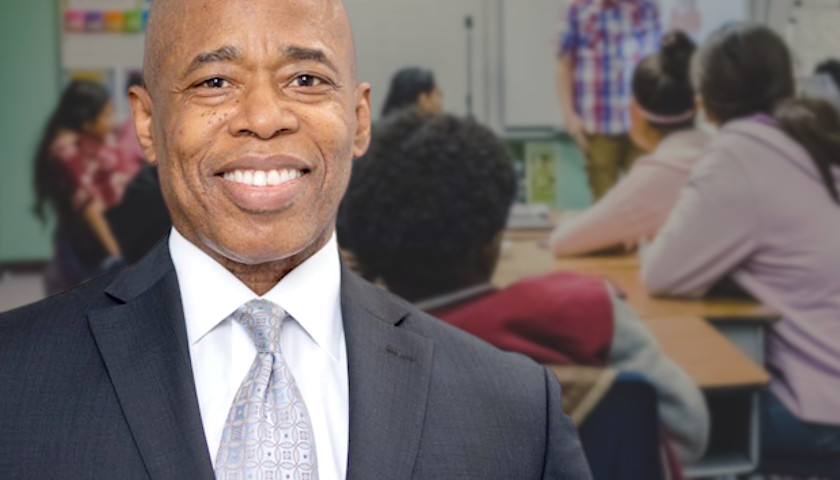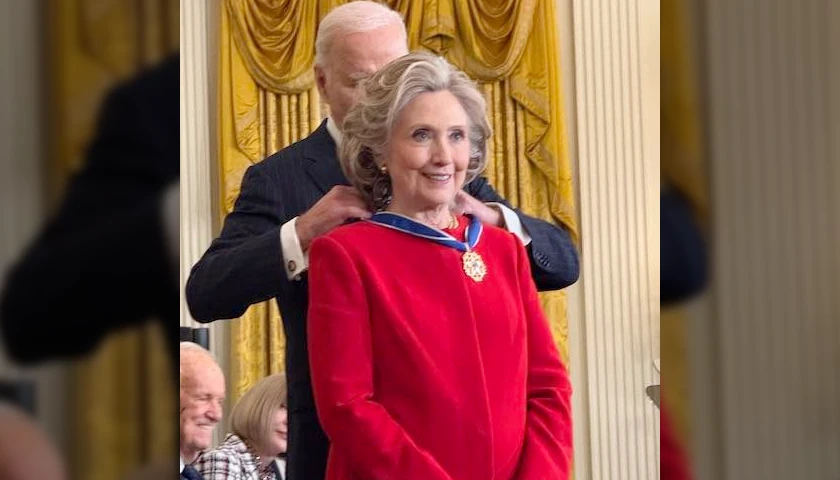by Vince Bielski
Mayor Eric Adams’ plan to save accelerated education in New York City from progressive critics begins with students like Cassy Thime’s daughter: a black second-grader who would thrive in a gifted classroom that today includes few kids of color.
“She’s a top student and a gifted program will give her a more rigorous education and push her to excel,” said Thime, who has a doctorate in education and lives in Queens. “Now she has classmates who can’t even read.”
Adams, who took office in January, is diving headfirst into a controversy over academically selective schools that’s dividing communities from San Francisco to Fairfax County, Va.
New York’s second black mayor rejects the criticism that accelerated learning is racist and must be dismantled because of the low number of students of color who qualify. He believes they should strive for an elite education, too. To help them, Adams and his new schools chancellor, David Banks, are staking a middle ground that embraces both competitive academics and diversity. If this longshot strategy works, New York could influence districts across the country.
As Banks sees it, the problem with selective schools boils down to scarcity – there are too few seats for advanced students in elementary, middle, and high schools for all who merit one. So the solution is pretty obvious: Create more elite schools and programs.
New York is starting with the addition of 1,100 seats to the gifted and talented (G&T) program for elementary students this fall. Identifying more advanced black and Latino students from the get-go means they will be bettered prepared to qualify for New York’s elite middle and high schools like Stuyvesant, Bronx Science, and Brooklyn Tech – schools that are under constant attack from progressives for admitting just a handful of blacks and Latinos.
To ensure that blacks and Latinos fill more of the seats in the expanding G&T program, Adams also has to change the admissions process. Citywide testing, in which all students across New York compete against each other for admission, has been an obstacle. Minority students (not including Asians) took only 16% of the gifted seats prior to the pandemic while making up about 63% of all elementary students, with whites and Asians occupying about 75% of the gifted slots, according to city data.
For this reason, Banks is dropping the citywide written test, which was taken mostly by white and Asian students whose parents signed them up. Now all preschool students will be evaluated by teachers for admission, and the top performing second-graders in each elementary school will also be invited to apply. This approach, employing what academics call “local norms,” means that students will compete against others in similar socioeconomic groups, reducing any academic advantage that growing up in wealthier school districts may provide.
The likely upshot is that a higher percentage of blacks and Latinos and a lower percentage of whites and Asians will be admitted into the gifted program, a racial rebalancing that has set off a backlash in other school districts. Asian parents in Fairfax County, Virginia, sued over a racial rebalancing at Thomas Jefferson High School for Science and Technology and lost at the Supreme Court in April.
But G&T advocates in New York are open to the rebalancing, as long as the pie is expanding for everyone and the admissions process is standardized and transparent. Chien Kwok of the Parent Leaders for Accelerated Curriculum and Education, an advocacy group of mainly Asian Americans, hailed Adams’ plan for embracing the concept that gifted kids in all communities are entitled to a rigorous education.
“In the past we were leaving gifted children behind,” Kwok said. “Now the program is expanding, it’s no longer a zero-sum game, so I’m supportive.”
A Win for High Academic Standards
Banks is also promising to bring a similar expansion to the city’s selective middle and high schools in the future. If that happens, it would benefit tens of thousands of students in the nation’s largest school system and send a message nationwide that high academic standards and racial equity don’t have to be at loggerheads.
“A lot of people are going to watch carefully to see how well this works,” said Jonathan Plucker, a professor at the Center for Talented Youth at Johns Hopkins University. “And I’m very confident that it will eventually evolve into something that’s going to be a huge plus for the country and a big win for excellence in education.”
That may be a bullish view considering the obstacles ahead. Banks has been scathing in his criticism of the Department of Education he now leads, calling it a broken, top-heavy bureaucracy that has struggled to make progress over the years in its most basic tasks, such as teaching students to read at grade level.
To improve the gifted program, teachers – most of whom are not certified to teach gifted students – need to be trained. Nor does the city have anything like a well-designed and up-to-date curriculum to challenge gifted students. Currently, gifted instruction varies greatly from school to school, and often doesn’t go much beyond the general education curriculum mandated by the state.
The chancellor will also have to contend with a dozen advocacy groups and parents in several of New York’s 32 districts that are ideologically opposed to competitive academic programs that separate students by abilities. These groups, such as New York Appleseed, have lobbied for years to abolish accelerated schools and place students of wide-ranging abilities – as much as six grade levels apart – in the same general education classroom to reduce racial segregation. The advanced students will help those who are academically behind, the theory goes, and everyone wins.
Progressives came close to achieving their goal, called Brilliant NYC, at the end of Bill de Blasio’s run as mayor last year. They are “appalled” that Adams rejected it in favor of a G&T redesign that they consider inherently elitist and without value to any students.
“The gifted and talented program is very contentious and this new administration is going backwards by expanding it,” said Allison Roda, a professor of education at Molloy College who helped develop Brilliant NYC. “Gifted and talented has always been used as a tool to segregate students and avoid integration.”
Flight From NYC Schools
The mayor’s buildout of gifted education, announced in April, was one of his first major policy decisions, reflecting an urgency to reverse the flight of wealthier families from the school system.
Even before the pandemic, according to Banks, families were leaving the troubled system in which 65% of black and Latino students never achieve reading proficiency. The enrollment drop has been most acute among younger, white, and affluent students, with the system losing almost 5% of students in pre-kindergarten through third grade in 2020-2021. That means less state funding for city schools.
“One hundred and twenty thousand families decided to vote with their feet and to say we are going to find other alternatives for our children,” Banks said in a speech on March 2. “That’s an indictment of the work that we have done.”
But the city is nowhere near the point of satisfying demand for accelerated education, even though G&T programs are typically no more expensive than general education classes. Today, the program reaches only a small fraction of students, with about 15,000 out of 65,000 rising kindergarten families vying for 2,400 seats, mostly in more affluent sections of the city. Manhattan’s upper west and east sides are rich in programs, while some low-income districts in the Bronx and Brooklyn have very few or none.
The long distance that young kids in low-income or remote areas have to travel to get to a G&T program is one reason so few blacks and Latinos participate. Cassy Thime, who lives with her daughter in Rockaway Beach, Queens, is more than eight miles from the nearest program.
By bringing the program to all school districts, and adding 100 new G&T kindergarten seats, Adams is taking a small first step in what needs to be a much bigger expansion if he hopes to meet the demand. The city is also creating 1,000 new seats for students in the third grade – spread throughout all the districts – an age when a child’s giftedness becomes more apparent. Banks said the additional seats were the baseline, not the ceiling, of a program he expects to grow.
New Admissions Screening
In order to be admitted to the gifted program in the past, four-year-old preschoolers had to earn a top score on a written test – an approach that both sides in the G&T debate deemed inappropriate. Preschoolers have no experience with written tests, and they are far too young to understand that it’s a gateway to a better education through college.
The other problem is that black and Latino families have been less likely than whites and Asians to register for testing, partly because gifted programs don’t exist in many poorer neighborhoods and parents may not have heard about them.
Banks says the screening of all kids in preschool provides the fix. Rather than giving students a test, preschool teachers will look for signs of giftedness in how children draw, read, speak, or add and subtract, and then recommend the top performers for the program.
But teacher screening comes with its own issues. For starters, preschool teachers currently lack the training to identify gifted traits – a specialty in itself – as they evaluate kids for the fall program. This opens the door to a selection process filled with bias, from a teacher’s subjective views of what constitutes giftedness to pressures from administrators to meet diversity goals.
“Without deep intensive training, teachers often recommend the compliant children, not the one that’s thinking out of the box, or the incessant questioner, or the one that’s completely disorganized,” said Elissa Brown, a former director of the Hunter College Gifted Center and co-president of GiftedNYS. “So, you’re going to get biased teacher ratings around who is gifted.”
The separate pathway into the program for third-graders is almost certain to bring in many more black and Latino kids. The top 10% of students in every elementary school in the city, based on their second-grade marks in four core subjects, will be invited to apply. The pipeline will draw equally from wealthier schools with many white students in places like in Park Slope, Brooklyn, and threadbare schools with mostly kids of color in areas like Harlem.
This local norms approach has significantly boosted diversity in gifted programs in places like Montgomery County, Maryland, and Houston. In Colorado’s Aurora Public Schools, a pilot project drawing students from 10 elementary schools into a gifted program shrank the underrepresentation of Latinos to 7% from 17%, and blacks to 2% from 6%. The success of the pilot prompted the district to expand it to another 10 schools, according to Scott Peters, a professor of education at the University of Wisconsin-Whitewater who co-authored a paper on the use of the local norms admissions process.
The Gifted Mishmash Nationwide
The controversy over G&T is partly a result of America’s scattershot commitment to educating gifted children. New York is one of eight states that have no requirements around gifted instruction, which means many upstate cities like Binghamton and Buffalo ignore it, Brown said.
New Jersey is one of about 25 states that require schools to offer gifted programs for students. Only 16 states, including North Carolina, also provide additional funding for such programs.
As a result, G&T education is a mishmash for the estimated 10% or more of public school students whom researchers have identified as gifted. G&T guidelines, data collection, accountability, oversight of programs, as well as teacher training are spotty across the country and hinder efforts to make improvements, according to the 2019 report by the National Association for Gifted Children.
The quality of gifted instruction also varies greatly. For elementary grades, the most common style – differentiated instruction – is also the most superficial: Advanced kids are given extra or harder worksheets in a general education classroom, or are asked to be de-facto teacher assistants to help other kids, Brown said. In increasing intensity, other approaches pull kids out of class for a few hours a week or cluster them in groups of four to six with a separate curriculum within general education classrooms. The most robust approach puts gifted students in their own dedicated classroom or entire school – the practice used in New York City.
As a result, G&T education is a mishmash for the estimated 10% or more of public school students whom researchers have identified as gifted. G&T guidelines, data collection, accountability, oversight of programs, as well as teacher training are spotty across the country and hinder efforts to make improvements, according to the 2019 report by the National Association for Gifted Children.
The quality of gifted instruction also varies greatly. For elementary grades, the most common style – differentiated instruction – is also the most superficial: Advanced kids are given extra or harder worksheets in a general education classroom, or are asked to be de-facto teacher assistants to help other kids, Brown said. In increasing intensity, other approaches pull kids out of class for a few hours a week or cluster them in groups of four to six with a separate curriculum within general education classrooms. The most robust approach puts gifted students in their own dedicated classroom or entire school – the practice used in New York City.
The concern among researchers is that popular approaches like differentiated instruction don’t give gifted children anywhere near the challenge they need to thrive. The gap between the abilities of average and gifted students is too wide for a teacher to adequately instruct all of them at the same time.
Consider IQ: The average score in the U.S. is about 100; most gifted students score at least two to three standard deviations above that, or 120 to 130.
“These students are at least one or two grade levels ahead in at least one subject,” she said. “There are fourth graders who can handle algebra. So why are they still doing simple computation?”
The expansion of gifted education in New York is part of the chancellor’s larger turnaround attempt of the city’s $38 billion-a-year Department of Education. Banks, a former school safety officer, teacher, and principal who has butted heads with the bureaucracy in the past, almost immediately eliminated the department position of executive superintendent, saving millions in salaries. He also plans to redeploy DOE bureaucrats into the classrooms where they can help understaffed schools.
To convey the challenges ahead, Banks told the story of a speech he gave at the historic Tweed Courthouse, the grand Romanesque building that serves as the department’s headquarters. As Banks was starting his talk, the teleprompter broke, forcing him to ad lib.
“It’s a classic example, $38 billion, and we can’t even get the teleprompter to work,” he said in March at The Forum at St. Bart’s. “There are so many pieces of the system that are dysfunctional. It’s a massive turnaround.”
– – –
Vince Bielski is a writer for RealClearInvestigations.





